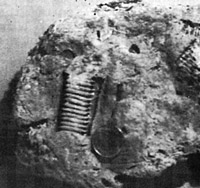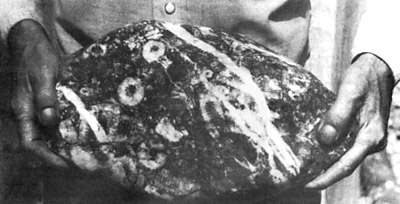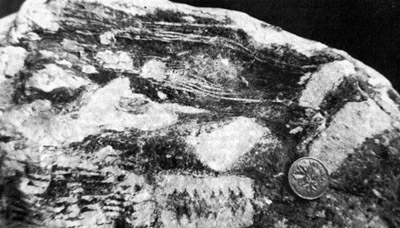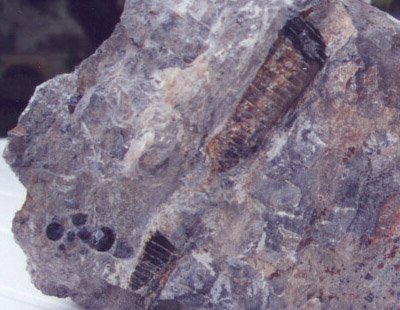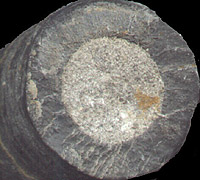 |
|||
|
|||
|
Copyright Some West Coast Crinoid Fossils BY PETER THORNE
These are Permian limestones formed 230 or more million years ago. All are of marine origin. The limestone belongs to the Chilliwack formation. A variety of marine fossils have been found in other and related limestones along the American-Canadian border and on the American side, limestone quarries have been in operation for many years. These limestones have produced branching corals, brachiopods (lamp shells) and other invertebrate marine fossils. At Slesse Creek the leading fossils are stems of sea lilies or crinoids. These are most often found in float; i.e., boulders in tributary creek beds. The limestone is a dark grey and impure. It could just as easily be thought of as a highly calcareous mudstone. When dissolved in hydrochloric acid there is considerable residue left not affected by the acid. It is because of this the acid will react faster with the purer white calcitic material of the sea lily stalk sections (columnals) and leave behind the shape of the columnal's interior (Figures 1 and 2); the former cavity of the axial canal.
The country here is extremely mountainous, rugged and densely forested; all of which makes finding the parent outcrops of these boulders a less than easy task. One such tributary creek with crinoidal boulders is the most northwest stream flowing into Slesse Creek. This one is easy to reach, being only a short walk from the main road on the south side. The crinoids are something of a mystery. No crinoid heads have been found. The head, or calyx, is used to identify crinoids. The calyx contains the animal's mouth and stomach. As this important part of the animal is missing, identification can only be made on the columnals, which is an uncertain business in this case. Only broad classification can be made. The columnals are quite large by local standards, an inch or more across. Crinoid columnals found on Vancouver Island are much smaller.
Running through the center of the columnals is the axial canal (Figure 5), making the columnal ring-shaped in cross section. Through this axial canal ran the axial cord. Also missing from the crinoid remains are holdfasts, the "roots"; the part that held the crinoid to the sea floor or whatever it used as an anchor. This would be as interesting to find as its calyx. The length of the column in life is unknown. Crinoid stem lengths vary from species to species; from a nub up to 21 meters (70 feet) in one fossil from. There are some modern species that are free swimming. Intermixed with the large columnals are much smaller ones. These probably represent the same species, as crinoids are communal, In fact are often referred to as growing in gardens. From the number of plates forming the skeleton of a crinoid, including the calyx, arms and holdfast, it may only be a matter of time before sufficient discoveries and research gives a positive identification to these mystery crinoids from Slesse Creek.
The Canadian Rockhound is grateful to John Ratcliffe for contributing the photographs in Figures 4, 5 and 6.
Copyright © 2001 Peter Thorne This article may not be copied, distributed or reprinted in any form without the author's permission. To contact the author, please use the e-mail address provided. If you are unable to contact the author, please contact the Canadian Rockhound. Authorized reprints must acknowledge the author, original source and the Canadian Rockhound, and include the website URL address of the Canadian Rockhound. The preceding article was first published in the Spring 1990 issue (Vol. 2, No. 6), of Cab & Crystal. Reprinted in the Canadian Rockhound with permission.
|
||||||
 
Copyright © 2001 Canadian Rockhound
Back Issues |
News & Events |
Junior Rockhound
|
||||||
